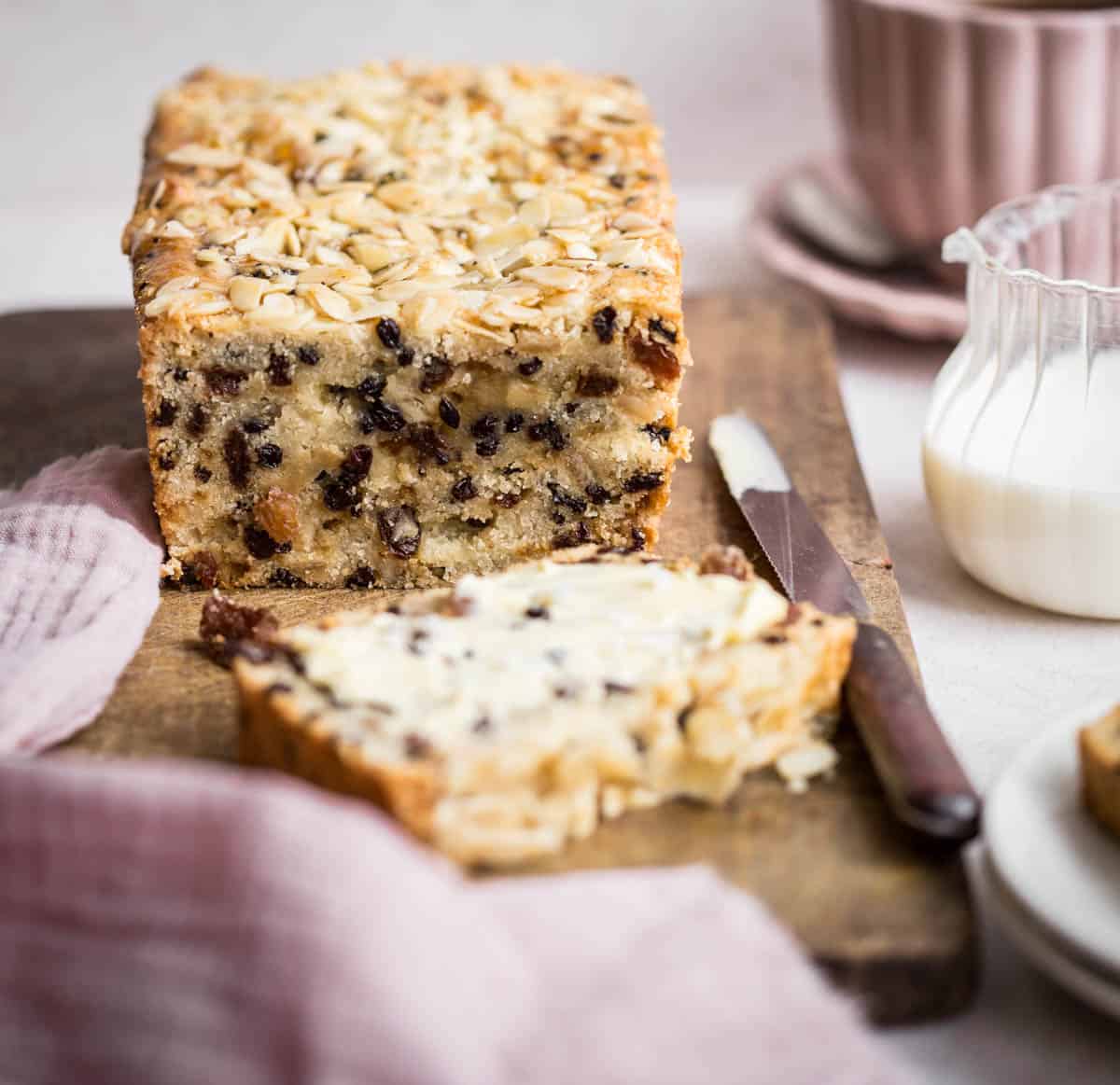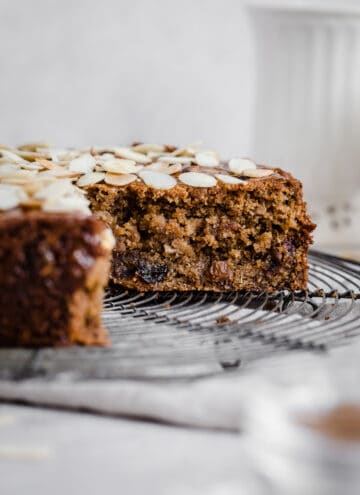This post contains affiliate links. Please read my disclosures.
Vinegar Cake is a very traditional fruitcake, thick with sultanas, currants and mixed peel. Extremely moist with a tender crumb thanks to the acidity of the not so secret ingredient of vinegar. It lends a deliciously soft tang to the flavour and is essential to the texture of the cake.
Jump to:
This is one of my family legacy recipes. My grandmother’s handwritten recipe of this traditional Vinegar Cake is one of my most cherished possessions. My mother salivates openly about her childhood memories of this old fashioned fruit cake slathered liberally with butter and marmite.
This is a slightly more modern version as I converted my grandmother’s recipe so I could use my favourite gluten-free flour blend but it can just as happily be made with all purpose plain white flour.
I’ll give you all the tips on how to make this easy recipe just as delicious as the one you might remember from your childhood. It has a simple method with no fancy equipment. All you need is a mixing bowl, wooden spoon and your favourite cake tin.

Why you’ll love this recipe
- Old fashioned easy fruit cake which is the perfect tea time bake.
- Deliciously moist crumb which holds plenty of juicy dried fruits.
- Very easy to make with simple ingredients and the bare minimum of kitchen equipment.
- Naturally egg free fruit cake so suitable for allergies and easy to make vegan.
- Keeps very well wrapped in foil for up to a week. In fact it improves the day after baking.
- This recipe is made with gluten-free flour but you can happily make it with plain white flour.
Ingredients needed

Flour. This recipe was tested using gluten-free flour but you can use all-purpose plain flour.
Butter. Unsalted butter is the best choice here. Make sure it is at room temperature.
Dried fruits. This recipe uses a mixture of currants, sultanas and mixed peel. You can use whatever you have to hand.
Caster sugar. A fine white sugar which gives lightness. You can substitute for granulated white sugar.
Bicarbonate of soda. Also known as baking soda, this is a white crystalline powder that is commonly used as a leavening agent in baking.
Milk. Use whole milk or a plant based milk if you are making dairy-free.
Apple cider vinegar. This ingredient gives the cake its name. The acidity gives the cake a lovely soft texture and a light tang. You can use malt vinegar which is probably what my grandmother would have used and would imbue a slightly different flavour. Although it isn’t gluten-free so that’s why I didn’t use it here.
Flaked almonds. This is a little nod to modernisation and makes the cake a little more pretty. It’s optional.
Marmalade. Again, this is merely for presentation purposes but it does add a lovely sweetness and pretty glaze to the top of the cake.
Flavour variations
Dried fruits. You can use any dried fruits you have to hand. Diced dried apricots, cranberries or glace cherries work really well here as well.
Soak the dried fruits. To enhance the moisture and flavour of your fruitcake, you could soak the dried fruits in rum, brandy, orange/apple juice or freshly brewed black tea for at least an hour before baking. This gives the fruits extra flavour and juiciness.
Glaze. You can add a little rum or brandy to the marmalade as you are melting it to brush over the cake once it has baked. You could also use apricot jam rather than marmalade.

How to make Old Fashioned Vinegar Cake
For full recipe instructions go to the recipe card at the end of this post.
- Preheat the oven to 180°C / 160°C fan assisted / gas mark 4 / 350°F and grease a 2lb loaf tin (8.5” x 4.5”).
- In a large bowl, Rub the butter into the flour until it resembles breadcrumbs.
- Stir in the dried fruit and sugar.
- Mix the bicarbonate of soda with milk and vinegar in a jug, then pour it into the dry ingredients until the mixture has a drop-like consistency.
- Pour the mixture into the loaf tin, sprinkle with flaked almonds, and bake for one hour.
- Remove from the oven, cool on a wire rack.
- Melt the marmalade in a saucepan until runny, then use it to glaze the cake.






Expert tips
- Use a 2lb loaf tin (8.5” x 4.5”) which is the size of the tin this recipe was tested with.
- Make sure all the ingredients are at room temperature before you begin.
- The bicarbonate of soda and vinegar make the milk froth up a fair bit so make sure the jug is large to accommodate this.
- Pre-heat the oven for at least 15 minutes before placing the cake in. You can check the oven is at the correct temperature by using an oven thermometer.
- Place the cake in the centre of the oven for even baking.
- Test for doneness by inserting a toothpick or cake tester into the centre of the cake. It should come out with a few moist crumbs when the cake is done.
- Allow the cake to fully cook before cutting it.

FAQs
The result depends on which kind of cake you are baking. In this traditional fruit cake vinegar acts as a leavening agent when combined with baking soda, making the cake tender, lighter and less dense. The acidity of vinegar also keeps the cake moist for longer which prolongs the shelf life of the cake. Important in an old fashioned recipe. The vinegar also adds a subtle tangy flavour that complements the sweetness of dried fruits and sugars.
You can use whichever vinegar you have to hand. This traditional recipe was originally made with malt vinegar but I switched it here for apple cider vinegar to make it gluten-free. Whatever vinegar you use will imbue a slightly different flavour.
Yes, this Vinegar Cake doesn’t contain any eggs so you only need to swap the butter for your favourite plant based butter and the whole milk for either oat milk or almond milk.
This traditional recipe stores very well. Keep in an airtight container (preferably not plastic) in a cool dark place wrapped in aluminium foil and the cake can keep for up to a week.
Absolutely. Allow the cake to cool completely then wrap up well in plastic wrap and aluminium foil and you can keep the cake in the freezer for up to 3 months. Thaw at room temperature overnight.
It delicious plain but even better slathered with butter and a sprinkling of sea salt. Or you could go the extra mile and add marmite like my mum used to do.
Shop the recipe
 Buy Now →
Buy Now → More traditional recipes you’ll love!
✨Have you tried this Vinegar Cake? Please leave a 5-star ⭐️ ⭐️ ⭐️ ⭐️ ⭐️ rating on the recipe card and consider leaving a comment as well! I would love to hear about how your recipe turned out and your feedback also helps other readers✨

Vinegar Cake
Ingredients
- 270 g gluten-free flour
- 200 g ground almonds
- 120 g unsalted butter - room temperature
- 160 g currants
- 160 g sultanas
- 40 g mixed peel
- 80 g caster sugar
- ¾ teaspoon bicarbonate of soda
- 300 ml whole milk
- 60 ml apple cider vinegar
- 25 g flaked almonds
- 1 tablespoon marmalade
Instructions
- Pre-heat the oven to 160°C / 140°C fan assisted /gas mark 3 / 320°F and line and grease a 2lb loaf tin. The loaf tin I used was 8.5” x 4.5”.
- In a large bowl whisk the flour together with the ground almonds then rub the butter in the flour mixture until it resembles rough breadcrumbs.
- Stir in the dried fruit and sugar.
- Pour the milk into a large jug and stir in the vinegar followed by the bicarbonate of soda. Allow the milk mixture to froth up then pour into the dry ingredients.
- Stir together with a wooden spoon until well combined.
- Pour the cake mixture into the loaf tin, sprinkle over the flaked almonds and bake in the oven for 60-70 minutes.
- Remove the cake from the oven and turn out carefully from the tin and leave to cool on a wire rack.
- Melt the marmalade in a small saucepan with a splash of water until runny then brush over the top of the warm cake.
- Allow the cake to fully cool before cutting and serving.







John Grieve says
Looking forward to trying this as a variant on Elizabeth West’s “keep-if-you-can cake”. Is the 150 temp for fan or conventional oven? Many thanks.
Georgina Hartley says
Hi John, 150 temp is for a fan oven, I'll clarify in the recipe - thank you!
Lucy says
Ooh I really want to make this, but I don't have millet flour. Could I sub any of the following: rice; oat; almond; tapioca; dove's farm GF? Thanks!
Georgina says
Yes! Oat flour would be a good substitution.